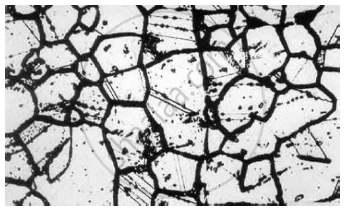Advertisements
Advertisements
Question
Define Electrochemical Corrosion. Explain Intergranular Corrosion with a neat diagram.
Short Note
Solution
The corrosion which is brought about through ionic reactions in the presence of moisture or solution as a conducting medium when two dissimilar metals are in contact with each other is called electro chemical corrosion. It also occurs when the metal surface is in immediate contact with aqueous acidic/alkaline/neutral/electrolytic solutions forming the short circuited galvanic cells.
- Intergranular corrosion (IGC), also known as intergranular attack (IGA), is a form of corrosionwhere the boundaries of crystallites of the material are more susceptible to corrosion than their insides. (Cf. transgranular corrosion.)
- This situation can happen in otherwise corrosion-resistant alloys, when the grain boundaries are depleted, known as grain boundary depletion, of the corrosion-inhibiting elements such as chromium by some mechanism.
- In nickel alloys and austeniticstainless steels, where chromium is added for corrosion resistance, the mechanism involved is precipitation of chromium carbide at the grain boundaries, resulting in the formation of chromium-depleted zones adjacent to the grain boundaries (this process is called sensitization).
- Around 12% chromium is minimally required to ensure passivation, a mechanism by which an ultra thin invisible film, known as passive film, forms on the surface of stainless steels. This passive film protects the metal from corrosive environments.
- The self-healing property of the passive film make the steel stainless. Selective leaching often involves grain boundary depletion mechanisms.

shaalaa.com
Types of Electrochemical Corrosion Intergranular Corrosion
Is there an error in this question or solution?
